What are the famous paintings that can be viewed in Sicily? If you are planning a trip, you might have asked yourself this question. Good news! There is no shortage of options, and you can choose from artists such as Caravaggio, Antonello da Messina and Guttuso. In this list, we have put together twelve famous Sicilian paintings, ranging from medieval to modern art and exhibited in the most prominent museums in Sicily or inside churches.
1) Vucciria – Renato Guttuso (Palermo)
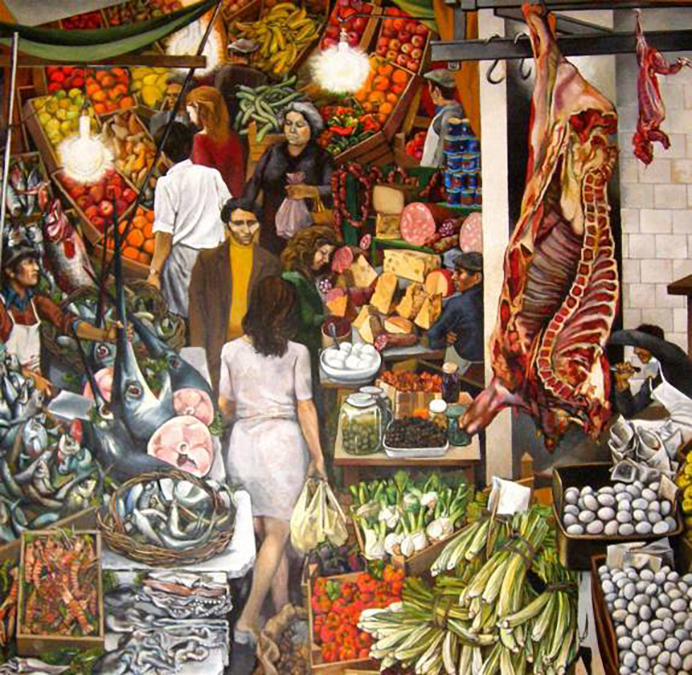
We begin this list of famous paintings in Sicily with a painting by one of the best-known artists, Renato Guttuso and his Vucciria. For his setting, the painter chose a place that can best express one of the many souls of Palermo, the famous historical market. A man walks between the stalls and a woman walks towards him with her back turned. Do they know each other? Are they looking at each other? In the moment frozen by the artist, the market all around them is alive. The butcher is preparing quarters of meat, the fishmonger is handling a swordfish and cheese, fruit and vegetable sellers are completing their sales. The woman whose back is turned is Guttuso’s muse, the model and fashion designer, Marta Marzotto, who was also the Bagheria painter’s lover for many years. This large canvas, measuring 3×3 metres, is on display in Palazzo Chiaramonte-Steri.
2) In the Room Women Come and Go – Renato Guttuso (Bagheria)

If you are a fan of Renato Guttuso then you absolutely must visit Bagheria, his hometown. A museum entirely dedicated to the Sicilian painter has been set up in Villa Cattolica. The paintings on display include some of his most famous paintings, but also a collection of film posters, various drawings of Sicilian cart paintings and a gallery of plaster casts. If you visit the museum, you can view the famous painting In the Room Women Come and Go. A painting that perfectly embodies Guttuso’s style and his passion for the female universe. Eight women in high heels, each doing something. Some are doing their hair, some are talking on the phone and some are hugging each other.
3) Triumph of Death – Unknown (Palermo)

The Triumph of Death is probably one of the most intriguing paintings you will encounter in Sicily (but perhaps not only here), especially considering the fact that it was painted in the 15th century. It is a fresco that was originally located in the courtyard of Palazzo Sclafani when it was the Great Hospital of Palermo. The painting was removed from the wall and moved to its current location in the Gallery of Palazzo Abatellis. The painter, who is unknown, may have portrayed a rather unusual scene in order to keep up the morale of the hospitalised patients. In the middle of a garden, death descends on an almost skeletal horse and attacks those present with a bow and arrow. However, not everyone, he kills nobles and prelates who are on the right and spares the poor, who occupy the left of the scene. It appears that this fresco even inspired Pablo Picasso for his painting Guernica.
4) Annunciata – Antonello da Messina (Palermo)

The Regional Gallery of Palazzo Abatellis holds various treasures. The most famous piece is still the Annunciata by Antonello da Messina. You will have seen this face at least once in your life. That’s why when you see this painting, you will be disappointed because you imagined it to be at least twice as big. Yet this in no way detracts from the beauty of this portrait. The Virgin Mary is depicted with a thoughtful, almost pensive face, holding the edges of her blue mantle together with one hand and seeming to protect herself from the apparition of the Archangel Gabriel with the other. The museographer, Carlo Scarpa, who was responsible for the conversion of Palazzo Abatellis into a museum, came up with a specific solution to enhance the painting and the light that strikes it. No spoilers, however.
5) Portrait of an Unknown Man – Antonello da Messina (Cefalù)
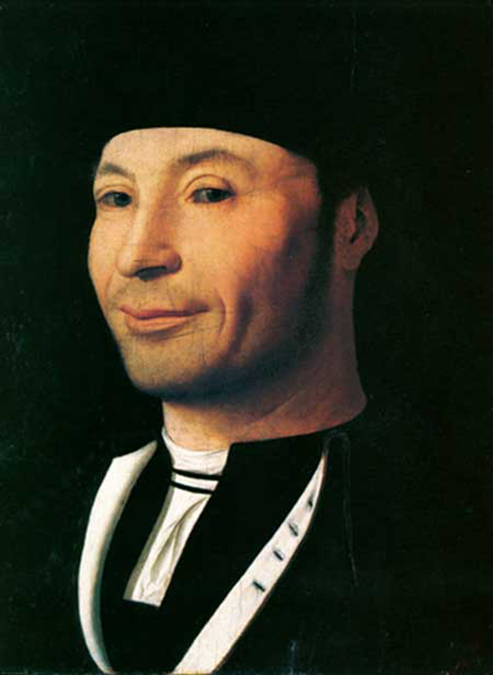
In the list of famous Sicilian paintings, there is, of course, another very famous painting by Antonello da Messina, namely the Portrait of an Unknown Man. Here the painter’s great talent for portraiture is evident. The subject’s almost mocking gaze seems to provoke the viewer and seek a reaction. It would seem, too, that someone did indeed lash out at this painting in the past, perhaps because of a disappointment in love. If you look closely, you can see cuts that not even restoration has been able to fix. Baron Mandralisca is said to have bought this painting from a pharmacist in Lipari who used it as the door of his cupboard. The painting is located in Cefalù, in the Mandralisca Museum. One more reason to visit a place that is one of the most beautiful villages in Italy.
6) Sin – Franz Von Stuck (Palermo)
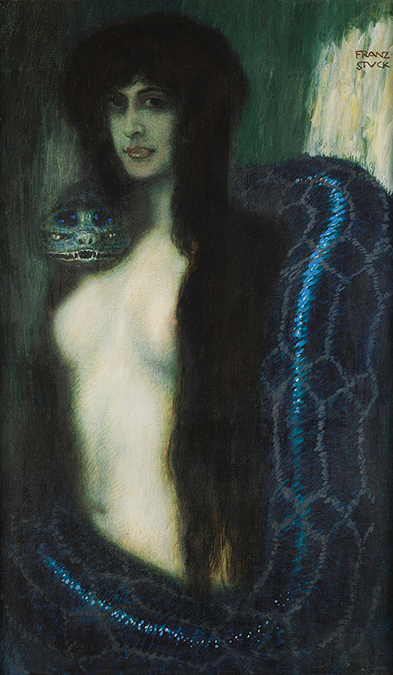
Sin (Die Sünde) is certainly Franz Von Stuck’s most famous painting and is considered one of the masterpieces of Symbolism. The German painter decided to represent the concept of sin with a naked woman with milky-white skin and a snake around her neck. The clear biblical reference is to Eve and the temptation of the serpent. The German artist liked this subject so much that 11 different versions of this painting are known to exist, one of which is in the “Neue Pinakothek” in Munich. The painting in the Galleria d’Arte Moderna in Palermo was bought in 1909 at the 8th Venice Biennale.
7) The Burial of Santa Lucia – Caravaggio (Syracuse)
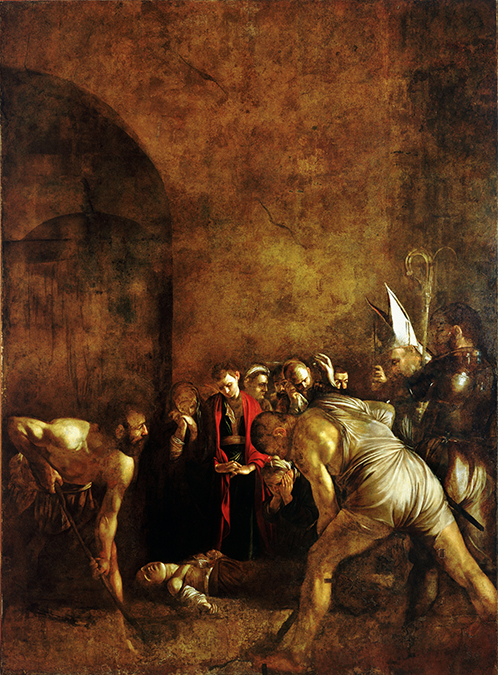
A great contribution to the list of famous Sicilian paintings comes from Caravaggio. The Lombard painter arrived in Syracuse in 1608 after having escaped from Sant’Angelo prison in Valletta. The first commission he received was The Burial of Santa Lucia. The subject to be depicted was perfect for the painter from Lombardy who, after being sentenced to death, was obsessed with decapitation throughout his life and depicted it in several paintings. The very interesting aspect of this painting is that Caravaggio seems to have set the scene in one of the Latomie in Syracuse. These were quarries from which stone blocks were extracted for use in constructing buildings. One of these is the Latomia del Paradiso where the famous Orecchio di Dionisio (Dionysius’ Ear) is located. It was Caravaggio who gave it this name. After changing locations three times in Syracuse over the last thirty years and being exhibited in various cities in Italy, the painting has now returned to its original location, the Church of Santa Lucia al Seppolcro.
8) Adoration of the Shepherds – Caravaggio (Messina)

At the Regional Museum of Messina, you can admire several famous Sicilian paintings. Two works by Antonello da Messina and two works by Caravaggio are on display. One of these is the Resurrection of Lazarus, the other is the Adoration of the Shepherds . For this painting, Caravaggio was greatly influenced by his patrons, the Capuchin Fathers of the Church of Santa Maria la Concezione in Messina. The painter from Lombardy decided to make a “poor” representation of the Nativity, a genre that would be very successful in 17th and 18th-century painting. The scene is set in a stable with Mary, exhausted from her journey and childbirth, lying on the ground holding the sleeping baby boy in her lap. The only details present, apart from the characters, are a loaf of bread, a napkin and a planer positioned on the left.
9) Self-portrait – Zheng Lai Ming (Catania)
The list of famous paintings to see in Sicily could not fail to include a work of modern art. The author, Zheng Lai Ming, is not Sicilian but from Singapore, although his self-portrait is part of the permanent collection in the MACS in Catania. It is a very large canvas, 240 cm x 192 cm, depicting the artist’s face. Zheng Lai Ming is famous for his hyperrealist paintings, yet throughout his career, he has experimented with different styles, including abstractism, impressionism and photo-realistic styles and often combining them in his work. If you take a closer look at this painting, you will notice this yourself. The portrait is, in fact, an oil painting made up of many small brushstrokes, rather like juxtaposition in Impressionist paintings.
10) Cristo in Gonnella – Unknown (Scicli)
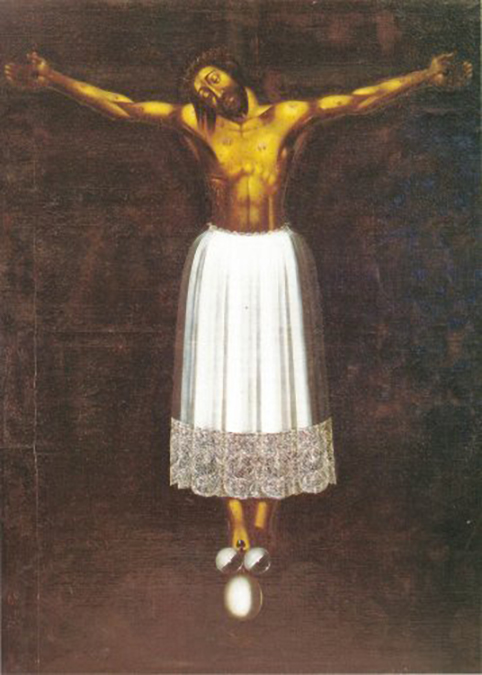
Every year, thousands of tourists visit the beautiful town of Scicli to admire its Baroque palaces and churches. In fact, it is one of the towns that is part of the Sicilian UNESCO site, The Late Baroque Towns of the Val di Noto. Fans of Inspector Montalbano go to Scicli for another reason as well. The Town Hall in Via Mormino Penna is, in fact, the building used for the external scenes of the Vigata police station in the TV series. There is a third reason to visit Scicli, however, and that is to see the Christ of Burgos, also known as the “Cristo in Gonnella“, in person. The painting is housed in the Church of San Giovanni Evangelista and is said to have been brought to the town by the Spaniard, Domingo de Cerratòn, who became Commander of the “Sargenzia” in Scicli. This very unusual way of depicting the crucifixion is popular in Spain and the Latin American world and was inspired by an ancient sculpture in Burgos Cathedral.
11) Love and Death – Calcedonio Reina (Catania)

The Catacombs of the Convent of the Capuchins are one of Palermo’s most atmospheric, also naturally macabre, sites. A network of corridors containing the clothed and perfectly embalmed bodies of prelates, shopkeepers, young women and children along its walls. In total, there are about 8,000 mummies, the most famous of which is that of Rosalia Lombardo. The Catanian painter, Calcedonio Reina, decided to use this very spot as the setting for his most famous and highly symbolic painting. In Love and Death, two young lovers indulge in a very intense kiss in the corridors of the catacombs. A reaction and a sign of attachment to life in a place where death is everywhere and seems to envelop the visitors. Almost a warning to enjoy life while there is still time, because time passes inexorably and the final moment comes sooner or later for everyone.
12) Madonna della Perla – Ignoto (Palermo)
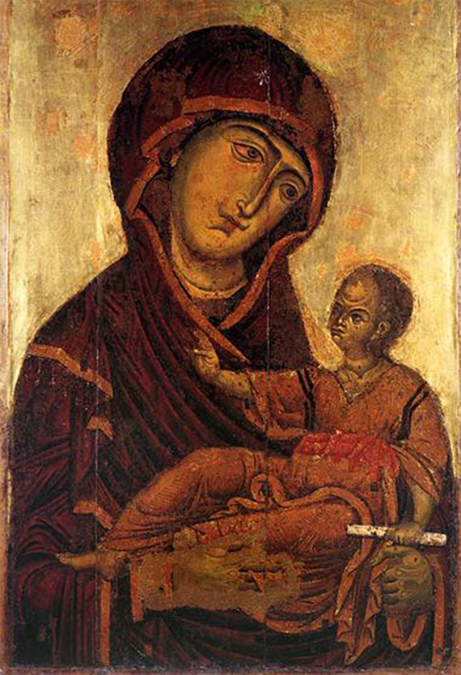
We conclude this list of famous Sicilian paintings with the so-called Madonna della Perla (Our Lady of the Pearl). The original title of the work is Madonna dell’Udienza (Madonna of the Audience), but it is also known as Madonna Imperlata or Madonna della Perla, due to the numerous pearls that once decorated the canvas in various places. The author, exact date and provenance of this painting are unknown. What is known is that it was donated by the Grand Chancellor, Matteo Ajello, in 1171 to the church of Santa Maria de Latinis. The painting remained on display there until the Second World War before being moved to its current location, the Diocesan Museum in Palermo. This Madonna della Perla has the typical artistic features of the Byzantine tradition and may have been painted in Sicily but commissioned by the Normans or may have come directly from the East. The Child’s high forehead and thoughtful attitude are clear symbols of divine wisdom, while the scroll he is holding is a symbol of his role as “teacher”.













